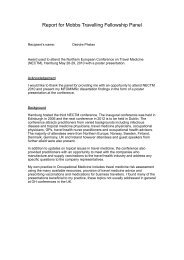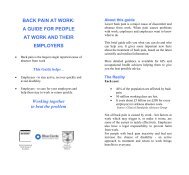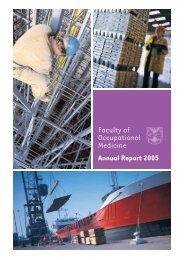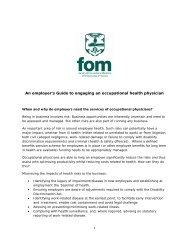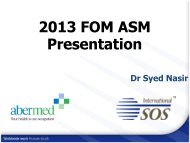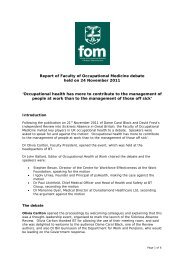Diphoterine for alkali chemical splashes to the skin at alumina ...
Diphoterine for alkali chemical splashes to the skin at alumina ...
Diphoterine for alkali chemical splashes to the skin at alumina ...
Create successful ePaper yourself
Turn your PDF publications into a flip-book with our unique Google optimized e-Paper software.
Faculty of Occup<strong>at</strong>ional Medicine<br />
Wilf Howe Memorial Prize 2012<br />
Winning submission by Dr Michael Donoghue<br />
<strong>Diphoterine</strong> <strong>for</strong> <strong>alkali</strong> <strong>chemical</strong> <strong>splashes</strong> <strong>to</strong> <strong>the</strong> <strong>skin</strong> <strong>at</strong> <strong>alumina</strong><br />
refineries.<br />
1. Clear description of innov<strong>at</strong>ion, initi<strong>at</strong>ive or intervention<br />
<strong>Diphoterine</strong> is a commercially available amphoteric, hyper<strong>to</strong>nic, chel<strong>at</strong>ing solution used <strong>to</strong><br />
decontamin<strong>at</strong>e and irrig<strong>at</strong>e <strong>chemical</strong> <strong>splashes</strong>. It was developed in France and is manufactured by<br />
Prevor.<br />
Alcoa of Australia oper<strong>at</strong>es three <strong>alumina</strong> refineries in Western Australia <strong>at</strong> Kwinana, Pinjarra and<br />
Wagerup. These three refineries employ about 3000 people and produce about 13% of <strong>the</strong><br />
world’s <strong>alumina</strong>. Much of <strong>the</strong> Bayer <strong>alumina</strong> refining process involves strong <strong>alkali</strong> solutions<br />
(primarily sodium hydroxide), which have <strong>the</strong> potential <strong>to</strong> cause <strong>chemical</strong> burns if <strong>the</strong> <strong>skin</strong> is<br />
splashed. There are, of course, many engineering and administr<strong>at</strong>ive controls <strong>to</strong> reduce <strong>the</strong><br />
likelihood of <strong>splashes</strong> occurring, but <strong>the</strong>re is residual risk and <strong>splashes</strong> do occur. It is <strong>the</strong>re<strong>for</strong>e<br />
important <strong>to</strong> provide <strong>the</strong> best first aid available <strong>for</strong> <strong>chemical</strong> <strong>splashes</strong>. Traditionally this has<br />
involved deployment of emergency showers and emergency eyewash st<strong>at</strong>ions in close proximity<br />
<strong>to</strong> any areas of risk. However, in 2003 Alcoa’s Environment Health & Safety Manager <strong>for</strong> <strong>the</strong><br />
Western Australian Oper<strong>at</strong>ions asked me whe<strong>the</strong>r I thought we should introduce <strong>Diphoterine</strong> <strong>at</strong><br />
our refineries. Following a review of <strong>the</strong> liter<strong>at</strong>ure and discussions with staff from <strong>alumina</strong><br />
refineries in <strong>the</strong> United St<strong>at</strong>es and South America I decided this would be a good idea, as it<br />
seemed likely <strong>Diphoterine</strong> would provide better first aid tre<strong>at</strong>ment <strong>for</strong> <strong>alkali</strong> <strong>skin</strong> <strong>splashes</strong>.<br />
I <strong>the</strong>re<strong>for</strong>e contributed <strong>to</strong> <strong>the</strong> deployment of <strong>Diphoterine</strong> <strong>at</strong> Alcoa’s three <strong>alumina</strong> refineries in<br />
Western Australia and <strong>the</strong>n evalu<strong>at</strong>ed <strong>the</strong> benefit of <strong>the</strong> initi<strong>at</strong>ive (see below). The deployment<br />
was undertaken by a multidisciplinary team including myself, occup<strong>at</strong>ional hygienists,<br />
occup<strong>at</strong>ional physicians, occup<strong>at</strong>ional health nurses, health and safety managers, line managers<br />
and procurement staff.<br />
In 2006 all employees and contrac<strong>to</strong>rs working in <strong>the</strong> oper<strong>at</strong>ional areas of all three refineries<br />
were trained in <strong>the</strong> use of <strong>Diphoterine</strong> and issued with a 100ml personal aerosol can, belt and<br />
carrying pouch. Employees and contrac<strong>to</strong>rs were trained <strong>to</strong> respond <strong>to</strong> <strong>skin</strong> <strong>splashes</strong> by<br />
immedi<strong>at</strong>ely removing contamin<strong>at</strong>ed clothing and applying <strong>Diphoterine</strong> from <strong>the</strong>ir personal can.<br />
They were instructed <strong>to</strong> discharge <strong>the</strong> entire contents of <strong>the</strong> can and <strong>to</strong> seek assistance from<br />
nearby colleagues if necessary <strong>to</strong> spray larger <strong>splashes</strong> with multiple cans. They were specifically<br />
advised th<strong>at</strong> <strong>the</strong>re was no need <strong>to</strong> shower be<strong>for</strong>e applying <strong>Diphoterine</strong> and th<strong>at</strong> <strong>the</strong>y should only<br />
shower if <strong>the</strong>y did not have access <strong>to</strong> enough <strong>Diphoterine</strong> <strong>to</strong> cover <strong>the</strong> affected <strong>skin</strong> promptly.<br />
The instruction <strong>to</strong> call <strong>the</strong> plant emergency number <strong>for</strong> emergency medical response by onsite<br />
ambulance if <strong>the</strong>y sustained or witnessed a large <strong>skin</strong> splash remained unchanged. The<br />
ambulances and medical centres were equipped with 5 litre canisters of <strong>Diphoterine</strong> and a large<br />
supply of 100ml cans.<br />
2. Description of working popul<strong>at</strong>ion<br />
All employees and contrac<strong>to</strong>rs working in <strong>the</strong> oper<strong>at</strong>ional areas of Alcoa’s three <strong>alumina</strong> refineries<br />
in Western Australia (Kwinana, Pinjarra and Wagerup).
3. Reasons <strong>for</strong> choosing 1 and 2, including organis<strong>at</strong>ional context<br />
Please refer <strong>to</strong> section 1.<br />
Please note: I have no affili<strong>at</strong>ion or financial involvement with Prevor, <strong>the</strong> manufacturer of<br />
<strong>Diphoterine</strong>. The initi<strong>at</strong>ive was funded by Alcoa of Australia.<br />
4. How did you measure outcomes?<br />
In order <strong>to</strong> evalu<strong>at</strong>e <strong>the</strong> effectiveness of <strong>the</strong> initi<strong>at</strong>ive I under<strong>to</strong>ok an audit of clinical cases seen <strong>at</strong><br />
<strong>the</strong> three refinery medical centres and I interrog<strong>at</strong>ed injury d<strong>at</strong>a from Alcoa’s Environment Health<br />
and Safety Incident Management System. The objective of <strong>the</strong> audit of clinical cases was <strong>to</strong><br />
determine if <strong>the</strong> clinical severity of <strong>chemical</strong> burns were any different when <strong>Diphoterine</strong> was applied<br />
first following <strong>chemical</strong> splash, compared <strong>to</strong> when w<strong>at</strong>er was applied first. This comparison was<br />
made possible when <strong>the</strong> <strong>Diphoterine</strong> program was introduced because some employees chose <strong>to</strong><br />
use <strong>Diphoterine</strong> first, whilst o<strong>the</strong>rs chose <strong>to</strong> apply w<strong>at</strong>er first. This is <strong>the</strong> largest clinical case series<br />
of <strong>alkali</strong> <strong>splashes</strong> tre<strong>at</strong>ed by <strong>Diphoterine</strong> reported <strong>to</strong> d<strong>at</strong>e. The objective of <strong>the</strong> injury r<strong>at</strong>e analysis<br />
was <strong>to</strong> determine if <strong>the</strong>re were any differences in <strong>the</strong> injury r<strong>at</strong>es <strong>for</strong> <strong>chemical</strong> burns be<strong>for</strong>e and<br />
after <strong>the</strong> introduction of <strong>Diphoterine</strong>.<br />
5. Wh<strong>at</strong> were <strong>the</strong> health benefits?<br />
180 cases of <strong>alkali</strong> <strong>splashes</strong> <strong>to</strong> <strong>the</strong> <strong>skin</strong> over a 17 month period were audited. There were no<br />
signs of a <strong>chemical</strong> burn in 52.9% of <strong>the</strong> group who applied <strong>Diphoterine</strong> first compared <strong>to</strong> 21.4%<br />
of <strong>the</strong> group who applied w<strong>at</strong>er first. Only 7.9% of <strong>the</strong> group who applied <strong>Diphoterine</strong> first had<br />
blisters or more severe signs compared <strong>to</strong> 23.8% of <strong>the</strong> group who applied w<strong>at</strong>er first. The<br />
differences were st<strong>at</strong>istically significant (P < 0.001). There were no st<strong>at</strong>istically significant<br />
differences between <strong>the</strong> two groups in ei<strong>the</strong>r time elapsed from splash <strong>to</strong> clinical assessment (P =<br />
0.496), or in body surface area splashed (P =0.233). After implement<strong>at</strong>ion of <strong>Diphoterine</strong> <strong>the</strong><br />
“OSHA first aid” injury r<strong>at</strong>e <strong>for</strong> <strong>chemical</strong> burns fell 24.7% (95% CI 0.5 – 43.0%). Applying<br />
<strong>Diphoterine</strong> first was associ<strong>at</strong>ed with significantly better outcomes following <strong>alkali</strong> <strong>skin</strong> <strong>splashes</strong><br />
than applying w<strong>at</strong>er first.<br />
I published <strong>the</strong> findings:<br />
Donoghue AM. <strong>Diphoterine</strong> <strong>for</strong> <strong>alkali</strong> <strong>chemical</strong> <strong>splashes</strong> <strong>to</strong> <strong>the</strong> <strong>skin</strong> <strong>at</strong> <strong>alumina</strong> refineries. Int J<br />
Derma<strong>to</strong>l 2010;49:894-900.<br />
6. Give an account of <strong>the</strong> difficulties / obstacles th<strong>at</strong> arose and how <strong>the</strong>y were addressed<br />
Several difficulties were addressed by <strong>the</strong> multidisciplinary team:<br />
1. Funding approval <strong>for</strong> <strong>the</strong> initi<strong>at</strong>ive was sought from senior management of <strong>the</strong> company. This<br />
involved explaining <strong>the</strong> evidence <strong>for</strong> <strong>Diphoterine</strong>’s effectiveness, <strong>the</strong> frequency of <strong>chemical</strong><br />
<strong>splashes</strong> <strong>at</strong> <strong>the</strong> refineries (despite engineering and administr<strong>at</strong>ive controls) and <strong>the</strong> cost of<br />
deployment.<br />
2. Approval of <strong>Diphoterine</strong> was sought from <strong>the</strong> Therapeutics Goods Administr<strong>at</strong>ion of <strong>the</strong><br />
Australian Government in order <strong>to</strong> enable import<strong>at</strong>ion of <strong>Diphoterine</strong> in<strong>to</strong> Australia <strong>for</strong> <strong>the</strong> first<br />
time. Specialised assistance was sought <strong>to</strong> undertake this process.<br />
3. Management, union represent<strong>at</strong>ives, contrac<strong>to</strong>r represent<strong>at</strong>ives and employees were engaged<br />
in workshops explaining <strong>the</strong> benefits of deployment.<br />
4. Training m<strong>at</strong>erials were developed and <strong>the</strong> program was “rolled out” using several means of<br />
communic<strong>at</strong>ion – electronic and face <strong>to</strong> face. This required repetitive messaging as <strong>the</strong>re was an<br />
entrenched culture of using showers <strong>for</strong> <strong>skin</strong> <strong>splashes</strong> and a reluctance <strong>to</strong> trust a new altern<strong>at</strong>ive.<br />
7. Explain how this might be used elsewhere<br />
<strong>Diphoterine</strong> could be usefully deployed <strong>at</strong> <strong>alumina</strong> refineries around <strong>the</strong> world. After discussing<br />
my experience with colleagues and publishing my findings, <strong>Diphoterine</strong> has been deployed <strong>at</strong><br />
<strong>alumina</strong> refineries oper<strong>at</strong>ed by o<strong>the</strong>r companies. It is also likely th<strong>at</strong> <strong>Diphoterine</strong> could be usefully<br />
deployed wherever <strong>alkali</strong> <strong>skin</strong> <strong>splashes</strong> could reasonably be expected <strong>to</strong> occur. For example in<br />
chlor<strong>alkali</strong> plants, various <strong>chemical</strong> industries, <strong>chemical</strong> pulp mills and industrial cleaning<br />
processes.



